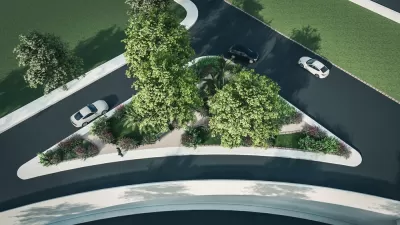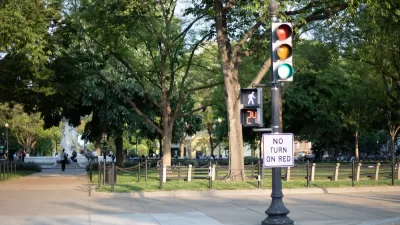Right-turn lanes can make traffic flow more smoothly, but make roadway conditions more dangerous for pedestrians and other road users on non-motorized vehicles.

"There is one roadway design feature that is becoming a point of contention in many communities and you’ve probably driven or walked through one at least once," writes Sam McCrory of the slip lane. Also known as channelized right-hand turn lanes, "Slip lanes are separate turn lanes that allow cars to make a right-hand turn without fully stopping for a red light at an intersection," McCrory explains.
If people driving are allowed to make an unimpeded right-hand turn, engineers believe that congestion will decrease. Slip lanes are also implemented for other reasons, like vehicle safety and consideration for larger vehicles. Slip lanes do help reduce t-bone style vehicle crashes, which are typically more dangerous to people driving; and because of their wide turning angle, slip lanes are more favorable for larger vehicles like semis, emergency vehicles, and delivery trucks to make turns in urban areas.
But there's one significant catch, writes McCrory. Slip lanes "are extremely dangerous for people using non-motorized means of transportation (walking, biking, etc)." According to the article, "In many scenarios slip lanes are completely useless and only cause confusion and negative safety outcomes for people using them. A simple way to increase safety is simply to stop implementing them."
McCrory recommends repurposing slip lane space "for things like bus stops, outdoor seating/gathering places, green space, and other uses," illustrating several potential examples at St. Louis intersections where slip lanes could serve more people-friendly purposes.
FULL STORY: IMAGINING ST. LOUIS WITHOUT SLIP LANES

Planetizen Federal Action Tracker
A weekly monitor of how Trump’s orders and actions are impacting planners and planning in America.

Congressman Proposes Bill to Rename DC Metro “Trump Train”
The Make Autorail Great Again Act would withhold federal funding to the system until the Washington Metropolitan Area Transit Authority (WMATA), rebrands as the Washington Metropolitan Authority for Greater Access (WMAGA).

The Simple Legislative Tool Transforming Vacant Downtowns
In California, Michigan and Georgia, an easy win is bringing dollars — and delight — back to city centers.

The States Losing Rural Delivery Rooms at an Alarming Pace
In some states, as few as 9% of rural hospitals still deliver babies. As a result, rising pre-term births, no adequate pre-term care and harrowing close calls are a growing reality.

The Small South Asian Republic Going all in on EVs
Thanks to one simple policy change less than five years ago, 65% of new cars in this Himalayan country are now electric.

DC Backpedals on Bike Lane Protection, Swaps Barriers for Paint
Citing aesthetic concerns, the city is removing the concrete barriers and flexposts that once separated Arizona Avenue cyclists from motor vehicles.
Urban Design for Planners 1: Software Tools
This six-course series explores essential urban design concepts using open source software and equips planners with the tools they need to participate fully in the urban design process.
Planning for Universal Design
Learn the tools for implementing Universal Design in planning regulations.
Smith Gee Studio
City of Charlotte
City of Camden Redevelopment Agency
City of Astoria
Transportation Research & Education Center (TREC) at Portland State University
US High Speed Rail Association
City of Camden Redevelopment Agency
Municipality of Princeton (NJ)





























